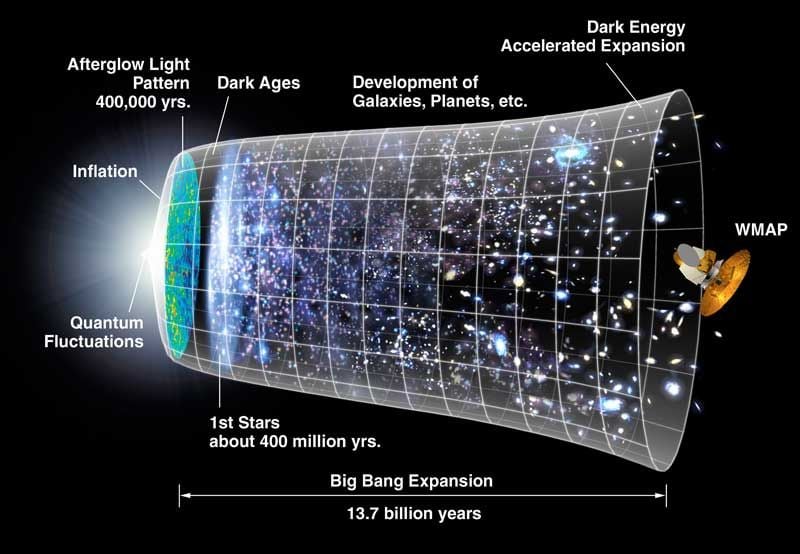A New Cosmic Discovery Could Be The Closest We’ve Come to the Beginning of Time
Scientists detect the signature of gravitational waves generated in the first moments of the Big Bang
/https://tf-cmsv2-smithsonianmag-media.s3.amazonaws.com/filer/fb/4a/fb4a9001-128e-4680-894f-e0019a81bbfb/bigbang-immagine-di-anateprima.jpg)
Some 13.8 billion years ago, just before the Big Bang, the enormous, galaxy-filled universe we know today was contained inside a tiny, dense, extremely hot point. Suddenly, it began rapidly expanding faster than the speed of light in a cataclysmic explosion. The universe grew from a subatomic size to that of a golf ball in an incomprehensibly short fraction of a second.
This earliest instant of expansion, known as cosmic inflation, explains why the universe is relatively uniform (galaxies that formed as the universe cooled, for instance, appear to be scattered evenly as far as the telescope can see) and also explains the seeds of density that gave rise to the universe’s structure.
It’s a nice story, but for decades after physicists proposed it, our evidence for it has been limited. Our chief means of studying the Big Bang—the faint radiation left over from the explosion called the cosmic microwave background (CMB)—dates to about 380,000 years afterward, instead of the moment itself.
A significant new piece of evidence emerged this morning, when a group of scientists led by astronomer John Kovac of the Harvard-Smithsonian Center for Astrophysics announced that they've found indirect evidence of gravitational waves—minute distortions in the universe's gravitational field—that were unleashed during inflation, a tiny fraction of a second after the Big Bang. If the finding is correct, the waves serve as a confirmation of inflation.
"Inflation is the 'bang' of the Big Bang," says theoretical physicist Alan Guth, who proposed the theory of cosmic inflation in 1979. "It's the mechanism that caused the universe to enter this period of gigantic expansion."
Several physicists who were not involved in the research have had the chance to assess the raw data, and they agree with the analysis. "It's very, very likely that this is real," says Avi Loeb, a theoretical physicist at the Harvard-Smithsonian Center, noting that the researchers spent three years analyzing the data to eliminate any chance of an error.
Robert W. Wilson, who shared the 1978 Nobel Prize in physics for his discovery of the cosmic microwave background, agrees, and believes that if confirmed, the work is almost certain to garner a Nobel Prize. Loeb says the finding would be one of the most important physics discoveries of the past 15 years—bigger than the discovery of the Higgs Boson.

The presence of detectable gravitational waves—often referred to as "ripples in the fabric of spacetime"—is predicted by the theory of inflation. Pre-existing fluctuations in the strength of gravity on a microscopic scale, Guth says, would have been stretched out by inflation, producing macroscopic waves.
The exact nature of the waves depends on the precise moment inflation occurred. "This detection is not only indicating that inflation took place,” Loeb says, “but also telling us when it took place": 10-34 (a decimal point followed by 33 zeros and then a one) seconds after the start of the Big Bang.
The research group, which also included Clement Pryke of the University of Minnesota, Jamie Bock of Caltech and Chao-Lin Kuo of Stanford, didn't find gravitational waves themselves, but rather indirect evidence of them, in the form of a special pattern of polarization caused by the waves in the cosmic microwave background. “Our team hunted for a special type of polarization called B-modes, which represents a twisting or curl pattern in the polarized orientations of the ancient light,” Bock said in a press statement.
The researchers collected this data using the BICEP2 telescope, stationed in Antarctica, where cold, dry air limits interference from the Earth’s atmosphere on the faint cosmic microwave background signal. BICEP2 is one of a suite of identical telescopes looking for this signature, called the Keck Array. There’s also the adjacent South Pole Telescope, which reported data that indicated the presence of B-mode polarization in the CMB last summer. That instrument, however, wasn't designed to detect polarization at the scale produced by gravitational waves, so it likely resulted instead from the interference of distant galaxies that the CMB passed through before reaching Earth.

It's still not entirely clear that the BICEP2 team has detected B-mode polarization that is in fact definitive proof of gravitational waves. Further confirmation will need to come from data collected by the European Space Agency's Planck Satellite (which is observing the cosmic microwave background at a much wider angle), due to be released at the end of the summer.
If true, though, the find would go a long way toward ratifying the theory of inflation. "The presence of this polarization, induced by the gravity waves, is the last big thing predicted by inflation," Wilson says. "It gives you ever-more confidence that this really is the correct scenario."
It would also reflect something truly astounding: the oldest evidence we have of absolutely anything.
"You can't use cosmic microwave background to figure out what happened in the early, early universe," Loeb says. For the first 380,000 years, the electromagnetic waves that make up the CMB couldn't pass freely through space. "If we can look at gravitational waves, we can go all the way back to almost the very beginning.”
/https://tf-cmsv2-smithsonianmag-media.s3.amazonaws.com/accounts/headshot/joseph-stromberg-240.jpg)
/https://tf-cmsv2-smithsonianmag-media.s3.amazonaws.com/accounts/headshot/joseph-stromberg-240.jpg)